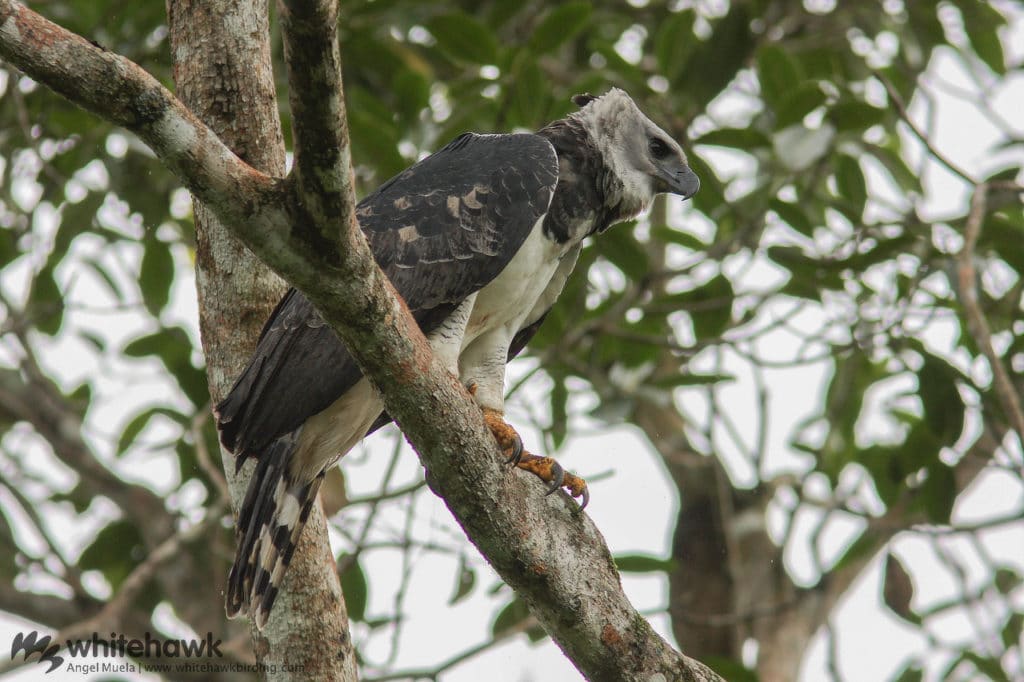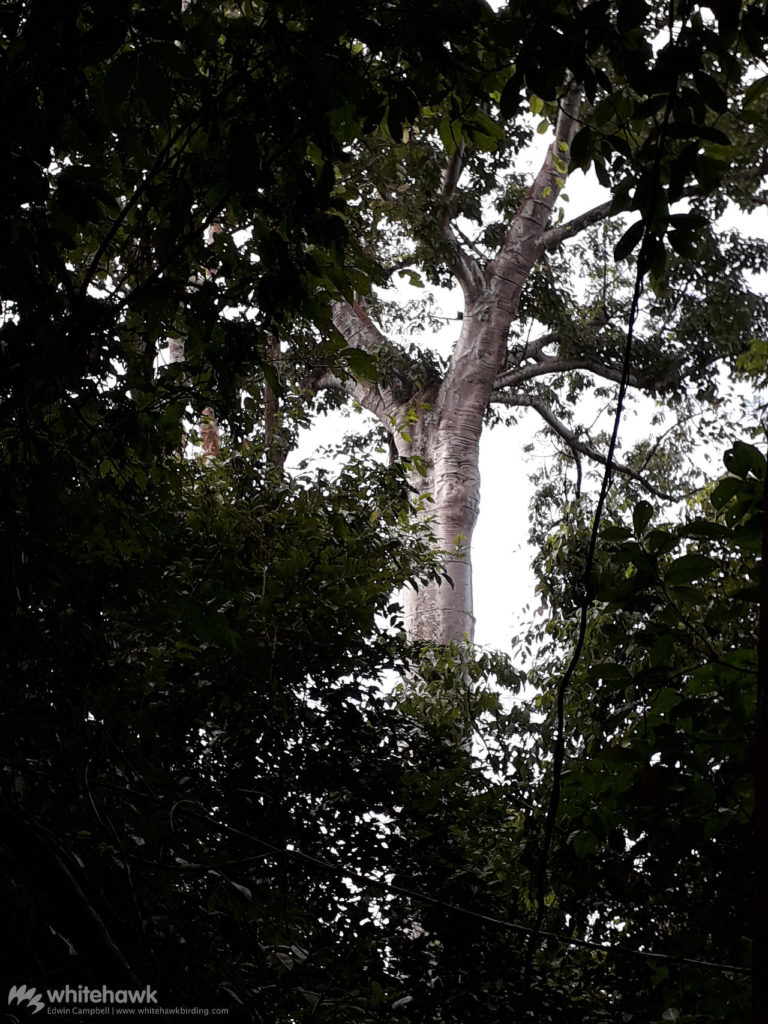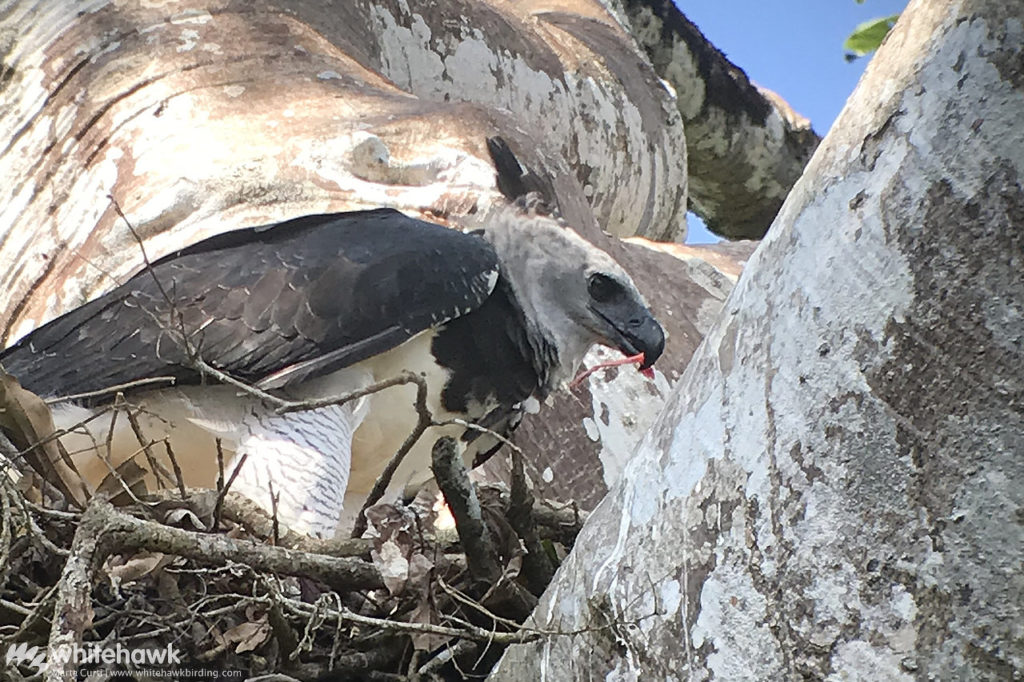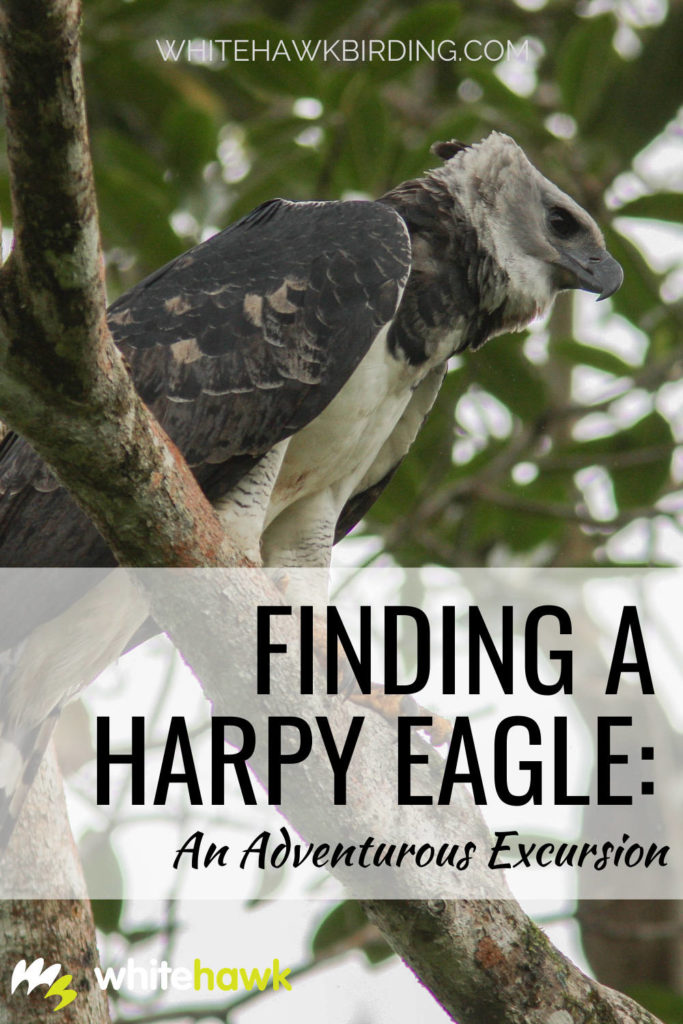
Harpy Eagles live in the mature lowland rainforests of Central and South America. They prefer large areas of expansive, intact forest, especially when it comes to nesting. Despite having a huge wingspan of 2 meters, Harpy Eagles do not soar above the forest canopy; they are truly a bird of deep forest. They can stay perched in one spot high in the dense foliage for hours at a time. If it is vocalizing, you may be lucky to track one down or see one fly when changing perches. Harpy Eagles can cover hundreds of meters in a matter of minutes on a single flight in the forest understory. Finding a Harpy Eagle by chance in a tropical rainforest is like finding a needle in a haystack.
There are well-known places to search for and see Harpy Eagles in Panama, Ecuador, Peru, and Brazil. While you may be very lucky to come across one by chance on a walk in the rainforest, that is a very rare occasion. The best chance of finding a Harpy Eagle in the wild is at an active nest site. It is more likely to see a juvenile and even adults at a nest site, especially if the chick is young. Getting to the nest is another story, and makes for a great adventure through the tropical rainforest!
What to Expect on a Harpy Eagle Excursion
While Harpy Eagles are occasionally seen in disturbed secondary forest and forest edge, to see a Harpy, you will have to go deep into the forest. Darien, the easternmost province of Panama, and in particular Darien National Park, is excellent Harpy Eagle territory. You will start your day very early, before dawn, and drive to the end of the Pan-American highway through the dark. Upon reaching a small town, Yaviza, you will embark on a “piragua,” a motorized dugout canoe. The morning light starts to emerge from behind the treetops that border the river. Birds begin their morning chorus, mingling with the roar of the boat motor. Waterbirds – Capped, Little Blue, and Cocoi herons – flee from the boat along the riverbanks.
Upon arrival at a small town deep in Darien, you step out of the piragua. The excitement of the adventure continues as you drive on equipped 4×4 vehicles along a rugged, bumpy road further into the “Darien Gap,” the stretch of land from where the Pan-American highway ends until it starts again on the other side of the border, in Colombia. Pastures and worked fields turn into forest. Oropendolas, toucans, tanagers, and other common birds fly overhead.
You reach the trailhead and now, with your pack on your back, are ready to hike into the jungle. The loud “gwack” of a Great Green Macaw is heard over the canopy. The sense of approaching a Harpy Eagle nest becomes even more real as the rainforest welcomes you with towering trees, screaming cicadas and smells of rain and rapid decomposition.
Getting closer…
With your guide and local indigenous community members, who know these forests and trails incredibly well, you venture further into the rainforest. Huge emergent trees come into view, ideal with radiating branches and a central bulky center perfect for the nest of a large raptor. A slow birding walk is not your priority right now, for the dream of seeing a Harpy Eagle in the wild is becoming real. Forest streams trickle by, and your feet may get a little wet from stream crossings along the trail. You watch for an elusive Agami Heron standing motionless along these quiet streams. Walking at a good pace, a long hike passes quickly with the building anticipation as you approach the nest site. Before you know it, you arrive.

Finding a Grail Bird in the Rainforest
After a morning full of adventure, excitement, and anticipation, your guide points to a gap in the dense rainforest canopy. You can see an impressive crown of a Cuipo tree, with its huge bare branches radiating off its thick trunk. This is the preferred nesting tree of the Harpy Eagle in eastern Panama. In the crook of the tree, you notice a large stick nest, and moments later, the white, fluffy tufts of feathers of a young Harpy Eagle. It lifts its head, giving you a first look at a wild Harpy Eagle in its nest. With the eaglet around 3 months old or younger, the adult Harpy Eagles are likely nearby. You wait, taking in every movement the eaglet makes from a ground blind placed at a safe distance from the nesting tree. The eaglet patiently waits too, for one of its parents to bring it breakfast.
Then, a shadow of a large bird with huge, wide wings 2 meters long, swoops in and perches on a large branch in the tree. You see its black breast band, gray face, and double feather crown. Then your attention focuses on its massive feet and talons, and new respect develops for this amazing predator. In those feet, the enormous female Harpy Eagle holds a three-toed sloth, seemingly effortlessly. After a pause, she glides down to the nest, responding to the begging calls of her chick. She starts to rip small pieces of flesh off the prey, feeding her chick ever so delicately. A moment with a Harpy Eagle is truly unforgettable, and for many, the sighting of a lifetime.

Considerations for Visiting a Harpy Eagle Nest
Finding a Harpy Eagle at a nest site is perhaps the most reliable way to see one in the wild. Nest sites are becoming more accessible in eastern Panama and some other parts of the Harpy Eagle’s range. This provides a great opportunity for birders and ecotourists to be able to see these top predators in the wild. Tour operators collaborate with local communities, indigenous guides, and landowners to protect the forests where Harpy Eagles are nesting. In this way, ecotourism provides economic support to locals in these remote areas, and thus encourages habitat protection.
It is important to note that it is the responsibility of the guides and all who trek to see Harpy Eagle nests that disturbance is kept to a bare minimum. Blinds are constructed at a safe distance and strict protocols are enforced to not disturb the nesting birds. As exciting as it is, voices must be kept to a whisper. Everyone who visits a Harpy Eagle nest is encouraged to wear neutral-colored clothing. Group sizes must be kept small and intervals between group visits are set in place. Harpy Eagles are somewhat tolerant of humans, but it is not worth the risk to disturb a nest site, especially when the eaglet is very young.
Come Experience Harpy Eagles with Whitehawk!
Join us in the extensive lands of Darien, Panama to see Harpy Eagles in the wild. We know the tips and tricks for finding a Harpy Eagle, and can get you there safely, with good chances of seeing these majestic birds. We can’t promise anything in nature, but we guarantee you a great adventure! Contact us for more information on seeing Harpy Eagles!
~ The Whitehawk Team


